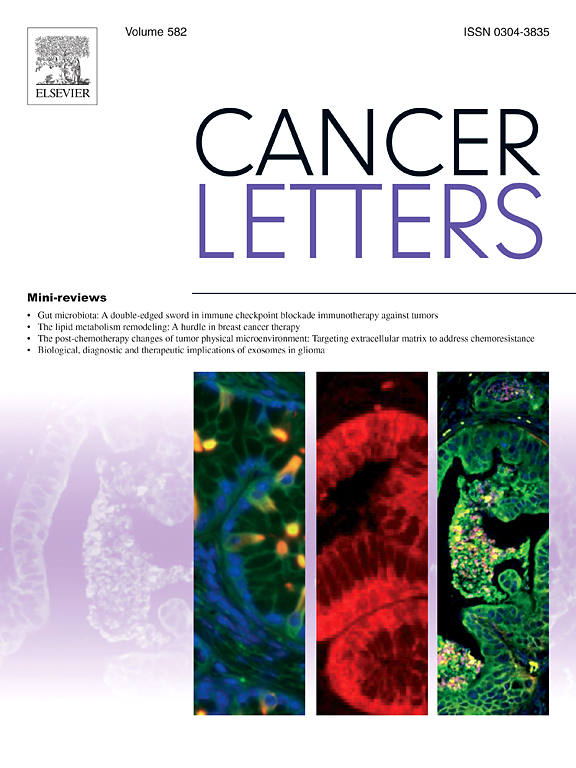ATF4:p52 complex activates oncogenic enhancers in multiple myeloma via p300/CBP recruitment to regulate BACH1
IF 9.1
1区 医学
Q1 ONCOLOGY
引用次数: 0
Abstract
Multiple myeloma (MM) is a B-cell malignancy accounting for 20 % of all blood-associated cancers. MM patients with a poorer prognosis and high-risk stratification were previously observed to be causally linked to the constitutive activation of non-canonical NF-κB (ncNF-κB) pathway. Consistent with this, the ncNF-κB p52 transcription factor was earlier found to regulate the enhancer landscape of MM to potentiate oncogenic transcription. However, the mechanism by which aberrant p52 expression is involved in coordinating enhancer activity has not been well explored. In this study, we analysed H3K27ac ChIP-seq and ATAC-seq data from MM cell lines and patient samples to screen for putative transcription factors that cooperate with p52 to regulate enhancers activated in MM. We report that ATF4 interacts with p52 and together, this complex mediates the activity of a subset of MM-associated enhancers through the recruitment of histone acetyltransferases (HATs), p300 and CBP (CREB-binding protein). We also identified a ATF4:p52 regulated target gene BACH1 under the regulation of a proximal super-enhancer, which was found to drive oncogenesis in MM by promoting cell cycle progression and proliferation. Together, our findings provide further mechanistic insights into how aberrant enhancer activation observed in MM tumours could lead to disease progression.
ATF4:p52复合物通过募集p300/CBP调控BACH1激活多发性骨髓瘤的致癌增强子
多发性骨髓瘤(MM)是一种b细胞恶性肿瘤,占所有血液相关癌症的20%。先前观察到预后较差和高危分层的MM患者与非典型NF-κB (ncNF-κB)通路的构成性激活有因果关系。与此一致的是,早期发现ncNF-κB p52转录因子可调节MM的增强子景观,从而增强致癌转录。然而,p52异常表达参与协调增强子活性的机制尚未得到很好的探讨。在这项研究中,我们分析了来自MM细胞系和患者样本的H3K27ac ChIP-seq和ATAC-seq数据,以筛选可能与p52合作调节MM中激活的增强子的转录因子。我们报告说,ATF4与p52相互作用,该复合物通过募集组蛋白乙酰转移酶(HATs)、p300和CBP (creb结合蛋白)来介导MM相关增强子子集的活性。我们还发现了ATF4:p52在近端超增强子的调控下调控靶基因BACH1,该基因通过促进细胞周期进展和增殖来驱动MM的肿瘤发生。总之,我们的研究结果为MM肿瘤中观察到的异常增强子激活如何导致疾病进展提供了进一步的机制见解。
本文章由计算机程序翻译,如有差异,请以英文原文为准。
求助全文
约1分钟内获得全文
求助全文
来源期刊

Cancer letters
医学-肿瘤学
CiteScore
17.70
自引率
2.10%
发文量
427
审稿时长
15 days
期刊介绍:
Cancer Letters is a reputable international journal that serves as a platform for significant and original contributions in cancer research. The journal welcomes both full-length articles and Mini Reviews in the wide-ranging field of basic and translational oncology. Furthermore, it frequently presents Special Issues that shed light on current and topical areas in cancer research.
Cancer Letters is highly interested in various fundamental aspects that can cater to a diverse readership. These areas include the molecular genetics and cell biology of cancer, radiation biology, molecular pathology, hormones and cancer, viral oncology, metastasis, and chemoprevention. The journal actively focuses on experimental therapeutics, particularly the advancement of targeted therapies for personalized cancer medicine, such as metronomic chemotherapy.
By publishing groundbreaking research and promoting advancements in cancer treatments, Cancer Letters aims to actively contribute to the fight against cancer and the improvement of patient outcomes.
 求助内容:
求助内容: 应助结果提醒方式:
应助结果提醒方式:


